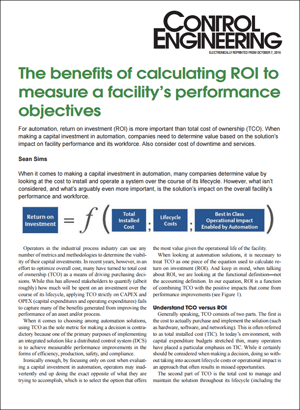Automation fundamentally impacts the costs and returns on a production process. When evaluating capital investments for instrumentation and automation, many manufacturers and producers look beyond the initial purchase, installation and commissioning costs to assess the costs throughout the lifecycle of this investment. While this total cost of ownership (TCO) approach improves upon initial purchase costs, it doesn’t well assess the full value delivered.
In a Control Engineering article, The benefits of calculating ROI to measure a facility’s performance objectives, Emerson’s Sean Sims identifies the considerations in looking beyond a TCO-based project analysis approach to a return on investment (ROI) analysis approach. Sean opens noting that return on investment is a function of total installed costs plus lifecycle costs plus operational impacts—improvements in operational performance—enabled by automation.
Sean opens noting that return on investment is a function of total installed costs plus lifecycle costs plus operational impacts—improvements in operational performance—enabled by automation.
TCO consists of two parts:
The first is the cost to actually purchase and implement the solution (such as hardware, software, and networking). This is often referred to as total installed cost (TIC). In today’s environment, with capital expenditure budgets stretched thin, many operators have placed a particular emphasis on TIC.
…
The second part of TCO is the total cost to manage and maintain the solution throughout its lifecycle (including the cost of decommissioning), which typically ranges anywhere from 30 to 40 years. It is this part of TCO that often distinguishes one option or vendor from another. However, in many instances, it takes a backseat in pre-front-end engineering design evaluations to the cost of acquisition.
Improved operational performance can come in many forms including:
…more precise control over a process, leading to increased throughput by being able to operate closer to production limits (control optimization). Throughput gains might also come from shorter batch cycle times, lower grade transition time, less product re-blending, and decreases in scheduled shutdown duration and frequency.
Some of the gains are more difficult to calculate:
…such as reduced unscheduled downtime, improved product quality, reduced variability, more effective maintenance, and increased operational visibility. These also can result in significant financial gains throughout the life of a facility, but they are often disregarded on account of the difficulty associated with assigning monetary value.
Sean provides examples of where well integrated and technologically current automation can improve operator decision making and workflows between plant staff members. For example, during shift changes [hyperlink added]:
…which typically are the most risk-laden time of the day at a production facility. An electronic logbook is a very simple control platform feature that provides personnel coming into the plant with critical information about what happened during the previous shift. It also provides context for future work activity, which drives efficiency in personnel usage and speed to resolution of abnormal process conditions.
Another example is unplanned downtime:
…due to equipment failure can typically be mitigated by implementing proactive strategies, such as asset health monitoring. For many operators, the cost associated with implementing instrumentation that provides the capability to perform this type of monitoring is reflected in TCO as a maintenance expense. But by accounting for benefits such as higher plant uptime and extended life of equipment—not to mention shorter equipment maintenance outages-the instrumentation is seen for what it truly is: a source of measurable and substantial savings.
Read the article for other areas of investments returns such as connected services for system health monitoring and more. Sean concludes:
To ensure that the optimal solution is selected, companies should look beyond TCO and instead apply ROI by taking into account the benefits that come from partnering with a control systems expert to implement an integrated solution. This includes any improvements in safety, reduced unplanned downtime, increased production, and improved workforce effectiveness.
Considering the total installed cost of automation solutions and the lifecycle costs for a project-along with the operational impact that is derived and enabled by automation from the aforementioned improvements-will allow for a selection of options that more appropriately aligns with the specific requirements and performance objectives of a facility. Doing so will ultimately lead to more efficient use of capital budgets in today’s increasingly cost-conscious environment.
You can connect and interact with other experts in assessing and managing value across the automation lifecycle in the Operate & Maintain group in the Emerson Exchange 365 community.





